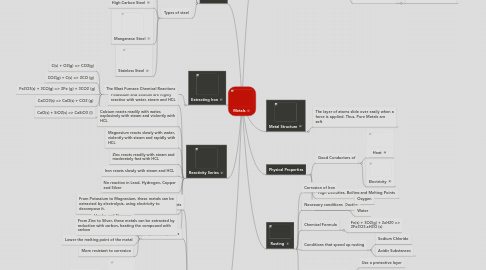
1. Alloys
1.1. Is a mixture of metal with one element and few or other elements
1.2. Physical Properties
1.2.1. Harder and Stronger
1.2.2. Improve the appearance
1.2.3. Lower the melting point of the metal
1.2.4. More resistant to corrosion
1.3. Examples of alloys
1.3.1. Brass
1.3.1.1. Copper + Zinc
1.3.2. Stainless Steel
1.3.2.1. Iron + Chromium + Nickel + Carbon
1.3.3. Solder
1.3.3.1. Tin + Lead
1.3.4. Pewter
1.3.4.1. Tin + Antimony + Copper
1.4. Alloy structure
1.4.1. Atoms in a added element comes with different sizes. Thus, the orderly arrangement of atoms is disrupted and cannot slide over easily when a force is applied. This is a reason why alloys are stronger than pure metals.
2. Reactivity Series
2.1. Potassium and Sodium are highly reactive with water, steam and HCL
2.2. Calcium reacts readily with water, explosively with steam and violently with HCL
2.3. Magnesium reacts slowly with water, violently with steam and rapidly with HCL
2.4. Zinc reacts readily with steam and moderately fast with HCL
2.5. Iron reacts slowly with steam and HCL
2.6. No reaction in Lead, Hydrogen, Copper and Silver
2.7. From Potassium to Magnesium, these metals can be extracted by electrolysis, using electricity to decompose it.
2.8. From Zinc to Silver, these metals can be extracted by reduction with carbon, heating the compound with carbon
3. Extracting Iron
3.1. The Blast Furnace Chemical Reactions
3.1.1. C(s) + O2(g) => CO2(g)
3.1.2. CO2(g) + C(s) => 2CO (g)
3.1.3. Fe2O3(s) + 3CO(g) => 2Fe (g) + 3CO2 (g)
3.1.4. CaCO3(s) => CaO(s) + CO2 (g)
3.1.5. CaO(s) + SiO2(s) => CaSiO3 (l)
4. Steel
4.1. Is an alloy of iron with carbon and other elements
4.2. Made by 2 stages
4.2.1. Removing Impurities by oxdation
4.2.2. Mixing with carbon and other elements to make various types of steel
4.3. Types of steel
4.3.1. Mild Steel
4.3.2. High Carbon Steel
4.3.3. Manganese Steel
4.3.4. Stainless Steel
5. Physical Properties
5.1. Good Conductors of
5.1.1. Heat
5.1.2. Electricity
5.2. High Densities, Boiling and Melting Points
5.3. Malleable and Ductile
6. Metal Structure
6.1. The layer of atoms slide over easily when a force is applied. Thus, Pure Metals are soft
7. Rusting
7.1. Corrosion of Iron
7.2. Necessary conditions
7.2.1. Oxygen
7.2.2. Water
7.3. Chemical Formula
7.3.1. Fe(s) + 3O2(g) + 2xH20 => 2Fe2O3.xH2O (s)
7.4. Conditions that speed up rusting
7.4.1. Sodium Chloride
7.4.2. Acidic Substances
7.5. How to prevent rusting?
7.5.1. Use a protective layer
7.5.2. Sacrificial Metal
7.5.3. Using alloys
8. Recycling Metals
8.1. Advantages
8.1.1. Helps to conserve natural sources
8.1.2. Helps to reduce environmental problems caused by extraction of metals
8.1.3. Saves cost of extracting metals
8.2. Disadvantages
8.2.1. Economic issues
8.2.1.1. Expensive
8.2.1.2. Cost include collecting,sorting,separating,cleaning and transporting
8.2.2. Social issues
8.2.2.1. produces less waste, poses danger to human health
8.2.2.2. less mining, more land to cope with increasing world population.
8.2.2.3. Effort and time needed to educate communities and businesses to practice recycling as a way of life
8.2.3. Environmental issues
8.2.3.1. cause pollution problems
